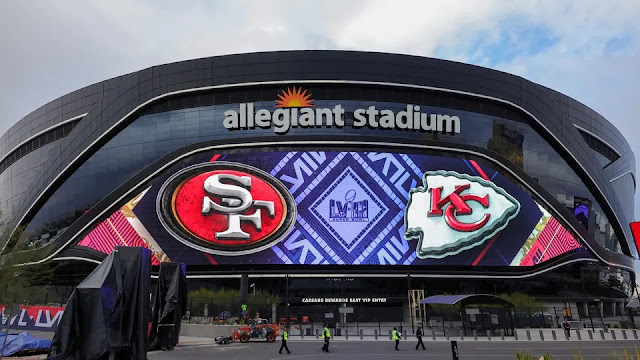Nevada gets 23% of its energy from solar and 37% of its energy from all renewable sources combined, according to the US Energy Information Administration. Rapidly shifting from fossil fuels to renewable sources is one key step in avoiding the worst effects of human-caused climate change.
Who doesn't love a good rematch? Sunday brings us a matchup of the NFL's most consistently dominant teams over the past five seasons, each of whom has something to accomplish with a victory.
When the Kansas City Chiefs and the San Francisco 49ers face off in Las Vegas this Sunday, they'll be doing so under lights powered by renewable energy. This year's Super Bowl host, Allegiant Stadium gets 100% of its power from renewable sources.
Allegiant Stadium is a domed multi-purpose stadium located in Paradise, Nevada, southwest of adjacent Las Vegas. Opened in 2020, it is the home field of the Las Vegas Raiders of the National Football League (NFL) and the University of Nevada, Las Vegas (UNLV) Rebels college football team. The stadium also hosts the Vegas Kickoff Classic in early September and the Las Vegas Bowl in December. The stadium will host Super Bowl LVIII.
The stadium has a roll-in natural Bermuda grass field similar to the one at State Farm Stadium in Glendale, Arizona, which is primarily used for NFL games. The main advantages of such a configuration is that it allows the natural playing surface to be exposed to natural sunlight when not in use and allows other events to be held at the facility without any risk of damage to the grass. Unlike the Arizona facility (which does not have a varsity tenant) Allegiant Stadium also has an artificial turf field, which is primarily used for college football games. This design was chosen because UNLV prefers to play on an artificial turf surface, and also due to concerns that the use of the grass field by two teams would cause excessive wear to the playing surface. The artificial turf is placed directly on the stadium's concrete floor and is rolled up and stored under the stadium when the tray is rolled in.
There are 2,700 parking spots surrounding the stadium and 6,000 in proximity to it. More than 35,000 parking spaces are located within a mile of Allegiant Stadium.
According to a press release from the Las Vegas Raiders, the stadium's main tenant, the stadium achieved that milestone in October. The team and the stadium's website don't spell out what renewable sources helped them achieve that goal, but more recent reporting says a big chunk of it comes from a Nevada-based solar installation. The Las Vegas Raiders have agreed to purchase power from the solar farm for 25 years, CBS reported.
Big-time sporting events at major stadiums are energy-hungry affairs. A stadium can require 5-10 megawatts of electricity during an event like an NFL game, enough to power around 5,000 homes. Covering that demand is certainly a step in the direction of sustainability.
But an event like the Super Bowl has a footprint that expands beyond the stadium's walls. While electric power generated from fossil fuels is the second largest source of greenhouse gas emissions, transportation is the largest and accounts for 28% of US emissions, according to the Environmental Protection Agency. Air travel to and from the game is part of an aviation industry that accounts for 2% of global energy-related carbon dioxide emissions, according to the International Energy Agency.
A win for the Chiefs would confirm them as a dynasty. The list of teams to win three Super Bowls in five years isn't long. the mid-1970s "Steel Curtain" Steelers, the mid-1990s Cowboys built by Jimmy Johnson, the Patriots with Tom Brady and Bill Belichick managed to pull it off twice in two different decades. That's it. A victory would put the Chiefs among the greatest five-year runs in league history, full stop.
The 49ers might believe they would be the dynasty if a few things had broken their way. They led the Chiefs by 10 points with seven minutes to go in the fourth quarter of Super Bowl LIV, only for Patrick Mahomes to carry Kansas City back. In the 2021 NFC title game, the Niners had a 10-point lead on the Rams to start the fourth quarter, but Jaquiski Tartt dropped an arm punt and the offense went cold at the wrong time. In the 2022 NFC title game, down to their third-string quarterback in rookie sensation Brock Purdy, the 49ers went into Philadelphia and lost Purdy to a serious elbow injury in the first quarter, which led to a 31-7 rout.
Five months ago, the season began with a Chiefs loss. Will it end with one? Who doesn't love a good rematch?


No comments:
Post a Comment